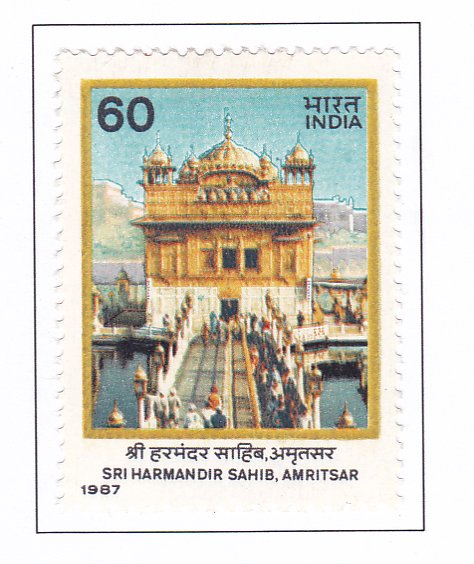400th Anniversary of Sri Harmandir Sahib, Amritsar

Technical Data
| Date of Issue | December 26, 1987 |
|---|---|
| Denomination | 60 p |
| Quantity | 1,500,000 |
| Perforation | comb 13 x 13½ |
| Printer | Security Printing Press, Nashik |
| Watermark | No Watermark |
| Colors | Multicolor |
| Catalog Codes |
Michel IN 1133 Stamp Number IN 1195 Yvert et Tellier IN 950 Stanley Gibbons IN 1282 |
| Themes | Anniversaries and Jubilees | Temples |
Commemorative Stamp: Sri Harmandir Sahib – Amritsar
Design Elements:
- Central Image: A stunning depiction of Sri Harmandir Sahib (The Golden Temple), highlighting its magnificent architecture with the golden dome and its reflection in the holy tank.
- Background: Subtle representation of the city of Amritsar and the “Lake of Nectar” (Amrit Sarovar) surrounding the temple.
- Symbols: Emblems representing the values of the Sikh faith—unity, humility, and spirituality—such as the Khanda (double-edged sword) and the Ik Onkar symbol (denoting the oneness of God).
Cultural and Historical Significance:
Sri Harmandir Sahib, also known as the Golden Temple, stands as a testament to the spiritual and historical traditions of the Sikhs. The foundation of the temple was laid by the fourth Sikh Guru, Guru Ram Das, in 1577. The sacred tank, known as the Amrit Sarovar, was constructed simultaneously, lending its name to the city of Amritsar.
The temple was completed under the guidance of the fifth Sikh Guru, Guru Arjan Dev, who invited Hazrat Mian Mir, a Sufi Muslim saint, to lay the foundation stone in 1588. The temple’s architecture, built below ground level, symbolizes humility. It is open on all four sides, representing openness and inclusivity, welcoming devotees from all walks of life.
Guru Arjan Dev also compiled the sacred scripture of the Sikhs, the Guru Granth Sahib, which was first installed in the Harmandir Sahib. The temple came to be known as the Golden Temple when Maharaja Ranjit Singh embellished its upper part with richly embossed gold sheets in 1803 A.D. The intricate filigree, enamel work, colored stone inlays, and sacred texts decorating the interiors add to its splendor.
Usage:
The stamp serves both postal purposes and as an educational tool, spreading awareness of the rich cultural and historical heritage of Sri Harmandir Sahib. It honors the temple’s 400-year history and its significance in promoting spiritual unification, humility, and service to humanity.
Importance of the Commemorative Stamp:
This stamp celebrates the profound spiritual and historical legacy of Sri Harmandir Sahib, highlighting its architectural beauty and the values it represents. It serves as a reminder of the temple’s role in fostering unity, humility, and devotion among its devotees, transcending barriers of caste, creed, and status.
Example of the Stamp Design:
- Main Stamp: Featuring a detailed image of the Golden Temple with its golden dome and intricate artwork, reflecting in the Amrit Sarovar.
- Supplementary Stamps:
- One stamp showing the city of Amritsar with the “Lake of Nectar.”
- Another depicting the Guru Granth Sahib being installed in the Harmandir Sahib.
- A third stamp illustrating the values of the Sikh faith, such as unity, humility, and spirituality, represented through symbols like the Khanda and Ik Onkar.
Significance:
The commemorative stamp set honors the 400-year-old legacy of Sri Harmandir Sahib, celebrating its architectural grandeur and spiritual significance. It highlights the temple’s inclusive ethos and its role in promoting spiritual unification and humility. The stamp set serves as a tribute to the timeless values embodied by the Golden Temple, inspiring reverence and devotion among people of all faiths.
